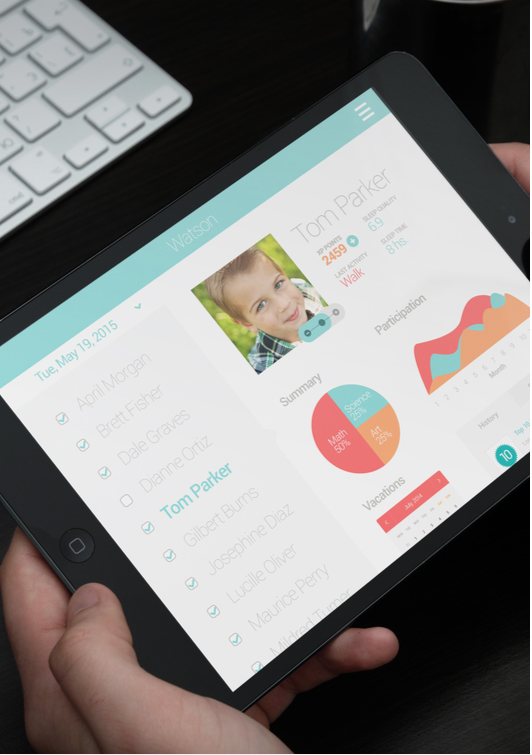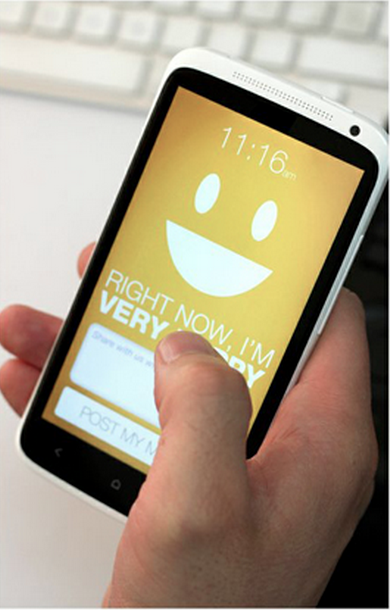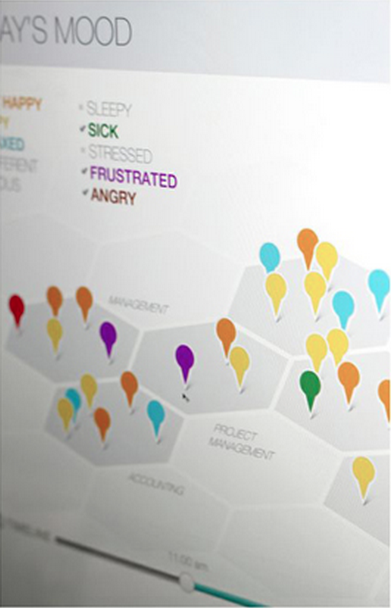
As a part of PSFKs’ “The Good Data Contest”, Zemoga wanted to create something that went beyond today’s connected classrooms. We wanted to create an app that was fun for kids to use, while parents, teachers and administrators could also gain valuable information and use that information to improve the education process. To that end, we created Jumpstart, a fully integrated, dynamic app that allows students, parents and administrators to work together to form a more comprehensive view of an individual child’s health.
Let us present to you, Jumpstart:

The Set Up:
It’s not enough for classrooms to simply be connected. As a parent, trusting in your child’s classroom experience is a requirement, but transparency into the events of the day is a luxury. Understanding the moments that matter and sharing simple insights with teachers lead to the simple but significant day to day course corrections that improve your child’s experience. This interaction and collaboration is infrequent and its absence contributes to poor performance by the child and low satisfaction for everyone. This can change with Jumpstart.
Beyond the technical fabric that brings teachers, students and parents together, greater classroom connectivity needs to do something relevant for us. Imagine a system of engagement that knows the conditions of the day (weather and community medical alerts), catalogs the reporting by parents (your child’s sleeping, eating and illness), observes the moments that matter through the day (playground activity and energy levels) and infers from all those contextual cues the recommendations that can make the next day and the learning experience better for your child.
Machine learning, computer vision, always-on intelligent sensing, indoor/ outdoor position location, and many other innovations will be part of the roadmap for the connected cognitive classroom. However, the starting point of Jumpstart can be much simpler by correlating a small set of initial indicators: sleep, diet, weather, public medical alerts and physical motion.
The Problem:
The country is currently focused on trying to enhance school performance, with standardized testing under scrutiny along with the overall quality of classrooms. Blame for poor experiences and low results is usually spread across the board between student, teachers, administrators and government. One thing is abundantly clear: Healthy and engaged kids perform better.
It’s hard to measure the level of “health” in a child and healthy interaction in a classroom. We know one thing for sure, a child who gets proper rest performs better. Their ability to think, react, remember and process tasks are all higher when appropriate amounts of sleep are being met. Studies into this are academic and techniques are rarely practical enough to implement in a basic classroom.
On top of that there has been little or no path to make the current insights from such studies “actionable”. Simple tracking and correlating the day to day experiences of a child will bring forward buried information that is helpful to parents and teachers and encouraging to the child too. This is where Watson comes in.
It’s one thing to know sleep is tied to performance, but how do you inform parents and encourage better behavior?

The Scenario:
Imagine a connected school that gave teachers, administrators and government better understanding of the “climate” of their students through observation. Imagine a connected school where you could help gamify the experience for kids to make better decisions about their sleep habits and performance. Imagine both teacher and parents having a better understanding of the unique drivers that will improve the experience of each individual child. Imagine the impact of a teacher having the aggregate view that most of her class got 5hrs of sleep and there is a flu bug circulating which could help her change tactics for the day in how she engages the full class or how a lesson is tailored for one individual child.
The Inputs:
Teachers:
The Jumpstart app for iPad will serve to take attendance and also input teachers perceived energy level of students. In the near future, other inputs like grades can be plugged into the system to make it smarter.
Students:
A BLE enabled device that will help monitor sleep and activity while providing an Apple Watch version of Jumpstart for students to make simple input decisions. At the same time, it is the base of a simple gamified system, that gives XP (Experience Points) to the kid based on their behavior and enables him/her to redeem points for practical rewards, previously set by the parents. Over time this can expand to additional, specialized wearable devices offered at several different price points.
Parents:
Parents interact with Jumpstart for iPhone to plug in kids’ bed time and a handful of simple daily inputs. It also works as a tool, that provides quick snapshots of kids’ weekly performance, food recommendations, etc.
CMS/Admin:
A secure interface built to manage local automation and workflows around all input sources, and provide analytics as the front-end user interface to the Watson analytics and feedback.
Additional data feeds directly into CMS according to the specific school:
- Health Alert information • Weather (via public APIs) • School-wide activities
- Testing days
Beacons:
Positioned in public areas like the hallways, gym and playground to monitor overall movement and frequency of visits. When in the gym are they sitting on the bleachers or actually being active? Are the kids going to the soda machine? If so, how often?
The Outcome:
All this data would get crunched and correlated by Watson and provide valu- able insights about a child and recommendations to make improvements in their daily habits. Given the fuller view, a parent can recognize the child needs to get to bed 20 min earlier or boost their diet; the teacher can encourage students to “look alive, let’s have fun and grab a healthy and energizing drink or fruit” rather than nod off in Mrs. Anderson’s class. The administration can tune schedules to compensate for the perfect storm of exhausted kids, a flu bug outbreak and a week of standardized testing.
Helping parents, teachers and students better understand their routines and behaviors is key to unlocking better performance. Encouraging balance through rest, education, and play matter greatly not just in school, but also in life. We see sleep as just the first step in unlocking the potential of each individual.
A DAY IN THE LIFE OF A JUMPSTART STUDENT
Sleep is important as it affects our ability to engage with the world. This couldn’t be more important than in regards to school aged children. With Jumpstart we want to empower kids to inform the world around them about how they’re feeling. By having Watson understand their sleep patterns and various other input points we will help create an environment for a kid to better engage with others.

06:00:
Tom is woken up by his apple watch, which calculated the appropriate time to wake him. He inputs his general mood upon waking up and begins his day. This info goes out to all other participants (parents, and teachers). It shows how many hours of sleep Tom got. This helps align expectations. **We understand that no kid is fully awake at 6am, but there are days that a kid is more eager to go to school than others. Capturing the kids general attitude/mood at beginning of the day is important, especially as it relates to sleep.
06:30:
As Tom is about to sit down and eat breakfast his mother or father inputs their perceived energy level of their child. They can also add additional information such as: what they ate and their perceived mood. It’s important to begin to understand: Do they seem stressed? Upset? Excited? All this information is going to the CMS and Watson. Chef Watson gives ideas of healthy breakfast according to previous data.
07:00:
Tom makes his way to school. He knows he can unlock XP points for participating in Jumpstart, which gives him access to rewards predefined by the parents with the help of Watson. Tom racked up 3000 XP points from the walk.
08:30:
Tom makes it to his first class, history. His teacher uses the Jumpstart app to take attendance and input her perceived energy level of each student. She can also see what Tom and his parents inputted that morning before coming to class. This helps her potentially adjust tactics if she knows that Tom is feeling anxious or excited. Tom has been very participative today, so his teacher gives him some XP points.
12:30:
Jumpstart has passive beacons throughout the school which help see at a high level if Tom skips lunch, or only sits on the bleachers at the gym, or visits a soda machine 4 times in a day. Additionally, using the Passbook app in the Watch, Tom can pay for food at the vending machines or the school cafeteria. Thankfully, Tom got lunch today and went with the healthier option which was registered by the system and unlocked more XP.
17:00:
Tom wraps up his day by trading in some XP for some video game play time with his favorite game, Destiny. As Tom prepares for bed, both he and his parents input their perceived energy levels. The app also informs Tom that if he gets to bed by 11 he could unlock more XP.

Potential Hurdles:
He largest hurdle in our mind is lack of participation. With any good survey, the best way to measure success is to have as many inputs as possible. This is why we wanted multiple input sources from the actual student, teacher, parents and beacons. We think using a device like the Apple Watch will help incentivize/encourage the kid to participate. We want to reward their efforts for participating as well, which is why we included awarding them with XP from a gaming platform like Xbox. Leveraging the Apple Watch and an Xbox in our mind helps the kid to feel empowered, which is important. We want the child to know it’s THEIR participation that makes a difference. For them to inform their world about how they’re feeling is crucial.
- Lack of participation
- Cost – Apple Watches can be expensive at scale
CONTACT: Chad Rodriguez. chad.rodriguez@zemoga.com
CONCEPT LEAD: Chad Rodriguez
TEAM MEMBERS: Juan Diego Velasco, Paul Magnone, Sebastian Zamora




















